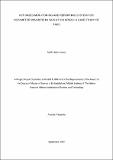Iot based monitoring and reporting system for dosimeter wearers in radiation areas: a case study of TAEC
Abstract
In today's modern society, the use of radiation sources in a wide range of activities has
increased rapidly. As a result, occupational exposure to ionizing radiation doses that cause
health effects increases. Excessive doses of 20 millisieverts (mSv) per year cause acute effects
such as sterility or cancer. The health effects of ionizing radiation fall in many countries around
the world, including Tanzania. Tanzania Atomic Energy Commission (TAEC) manages
dosimeters in order to reduce radiation hazards to radiation workers. Nonetheless, after
dispatching those dosimeters, the TAEC management room is unable to determine whether or
not each supposed wearer has worn the dosimeter. This originates from an incorrect assessment
of an individual occupational radiation dose. Therefore, an Internet of Things-based
Monitoring and Reporting System for Dosimeter Wearers in Radiation Areas is developed.
Using internet of things (IoT) technology, this project presents an effective and affordable
system for real-time remote monitoring and reporting staff wearing passive dosimeters while
near or in the area; radiation exposure is too high. The scrum method, which is based on agile
methodology, was used for system development. The system was run by an ESP32
microcontroller board that was programmed in C using the Arduino Integrated Development
Environment. The ESP 32 microcontroller could send data to the weber server via its built-in
Wi-Fi. Through the mapping web application, the end-user (TAEC Managerial Officer)
monitored and visualized radiation workers. IoT enabled the dosimeter to be monitored and
reported on at any time via the internet.

